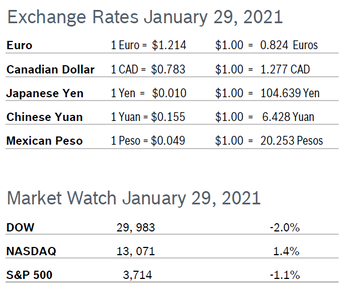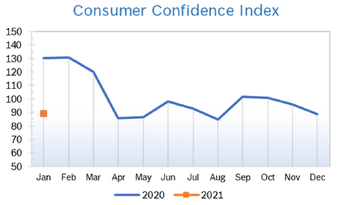|
Markets closed out a very volatile year on a high note, with the DOW and S&P closing at record highs and the NASDAQ hitting a record high before falling back slightly. After plunging in February and March, markets began recovering as the economy found footing, and generally trended upwards for the remainder of the year. For all of 2020, the DOW gained 7.25%, the S&P rose 16.3% and the tech-heavy NASDAQ soared 43.6%. Consumer Spending Falls 0.4% Consumer spending fell 0.4% in November after rising a downwardly revised 0.3% in October. It was the first decline in consumer spending since April. With new CV19 cases accelerating in much of the country, many states are adopting new restrictions and have closed or limited hours and capacity at retailers and restaurants and curtailed events and gatherings. Personal incomes fell 1.1% in November as unemployment programs and other aid programs expired. It was the third drop in personal incomes in the last four months. Consumer spending accounts for 70% of US economic activity. Consumer Prices Rise 0.2% The Consumer Price Index (CPI) rose 0.2% in November after being essentially flat in October. The CPI was up 1.2% year over year for the second consecutive month. Excluding the volatile food and energy components, core prices rose 0.2% after being unchanged in October. In the 12 months through November the rate of increase for core prices remained 1.6%. Economists expect inflation to remain under control in the coming months until vaccines are widely available and consumers feel more confident about shopping, attending events and traveling. Shelter prices rose just 0.1% for the third consecutive month, with rental prices trending down. Shelter accounts for 42% of the core CPI, which should keep a lid on overall price growth. Wells Fargo expects inflation to increase, but remain below the pre-pandemic trend for quite some time. Consumer Confidence Falls to 88.6
Unemployment Remains at 6.7%
Job Openings Rise More than Expected U.S. job openings rose by about 100,000 jobs in October to 6.65 million after rising to 6.4 million in September, according to the latest Job Openings and Labor Turnover Survey (JOLTS) from the US Bureau of Labor Statistics (BLS). Job openings are still 5% below pre-pandemic levels in February but indicate that the labor market is recovering more quickly than payrolls would suggest. Wells Fargo notes that at one point job openings were down 31% year over year. By the October report they were down 9%, well within the range of the two prior downturns, and below the contraction during the Great Recession. The labor force has fallen by 4.1 million workers since February; many people have stopped looking for work over concerns about childcare and healthcare, including people sick with CV19 or in quarantine. Wells Fargo also noted that due to the relatively small sample-size, JOLTS may be painting a distorted picture, as response is coming from stronger businesses that have kept their doors open and are responding to the survey. JOLTS is a lagging indicator but is closely watched by the Federal Reserve and factors into decisions about interest rates and other measures. Chicago PMI Rises to 59.5 The Chicago Purchasing Managers Index (Chicago PMI) rose to 59.5 in December after falling to 58.2 in November and remained in positive territory for the sixth consecutive month after spending a full year below 50. New Orders fell two points, but Production inched up just over a point as business activity picked up. Prices Paid rose 2.2 points to the highest level since 2018, with firms reporting higher prices for metals. The special question asked in December concerned respondents’ business activity forecast for 2021. Just under half of the respondents believed their businesses would grow less than 5%; the remainder expected growth between 5% and 10%. Looking back to when the series began in 1967, the PMI has ranged from 20.7 in June 1980 to 81.0 in November 1973. Wholesale Prices Rise 0.1% The Producer Price Index (PPI) rose 0.1% in November after rising by the same percentage in October. The increase was in line with expectations. The PPI has risen for five consecutive months, but at a very slow pace. In the 12 months through November the PPI rose 0.8% after being up 0.5% year over year in October. Excluding the volatile food, energy and trade services components, producer prices rose 0.1% in November after rising 0.1% in October and were up 0.9% over the past twelve months. Over the past 12 months the PPI for inputs to new residential construction has jumped 6.6%, driven by climbing prices for many of the materials used in construction. Regardless, strong demand from builders and remodelers may keep prices high, according to Data Digest from the Associated General Contractors of America (AGC). Analysts noted that while pandemic-related price distortions are reversing, the trend in inflation is expected to remain subdued for some time. Q3 GDP Revised up to 33.4% GDP growth for the third quarter was revised up slightly to 33.4% from 33.1%, according to the third and final estimate from the Commerce Department. The third quarter rebound followed a record 31.4% decline in the second quarter that reflected the impact of business lockdowns and other restrictions put in place to combat the pandemic. Analysts believe that after two quarters of distorted data, GDP will return to a somewhat more normal growth rate in the fourth quarter of 2020, when economists expect growth of about 3.5%. Thus far the economy has proven more resilient than expected. The Fed recently revised their 2020 GDP forecast to a decline of 2.4% compared to the prior estimate of a 3.7% drop. Forecasts for 2021 GDP range from 3.9% to 5.9% growth. Stimulus Package Passed After months of tense negotiations, Congress passed a $900 billion CV19 relief bill just before Christmas. Despite saying he would veto the bill because the stimulus checks to individuals were not large enough, President Trump signed it into law late on December 27, averting a partial government shutdown. The bill provides $600 for each American making less than $75,000 annually, as well as $600 for each dependent. The legislation also gives unemployed workers a $300 weekly federal payment that runs through March 14th and makes food stamps payments more generous. The Paycheck Protection portion of the bill contains more funds that should be accessible to more small businesses. The bill also provides funding for states to handle vaccine distribution. © Robert Bosch Tool Corporation. All rights reserved, no copying or reproducing is permitted without prior written approval.
|
|










